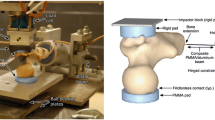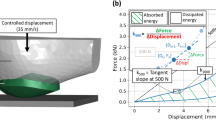Abstract
Recent studies have shown that factors related to fall biomechanics may play as important a role in the etiology of hip fracture as age-related bone loss. Motivated by finite element analyses that showed failure of the proximal femur to be sensitive to loading direction, our objective with the current investigation was to determine experimentally if changes in impact direction affect the failure load of the elderly proximal femur. Thirty-three cadaveric femurs were assigned randomly to three groups of 11 and tested at one of three loading angles, 0°, 15°, or 30°, representing a fall on the hip rolled slightly forward, to the side, or rolled slightly backwards, respectively. Femurs were scanned using dualenergy X-ray absorptiometry (DXA) to assess bone mineral density (BMD) and tested to failure in a fall loading configuration at a displacement rate of 100 mm/second. Using an analysis of covariance to adjust for total hip BMD, we found that failure load decreased by 24% as the loading angle changed from 0° to 30°. This reduction in failure load is comparable to that associated with about 25 years of age-related bone loss after the age of 65. Therefore, the impact direction associated primarily with a fall is a critical determinant of hip fracture risk that is both independent of bone density and associated with fall biomechanics.
Similar content being viewed by others
References
American Academy of Orthopaedic Surgeons (1993) A position statement: prevention of hip fractures. AAOS (proceedings), Rosemont IL
Cummings SR, Rubin SM, Black D (1990) The future of hip fractures in the United States: numbers, costs, and potential effects of postmenopausal estrogen. Clin Orthop 252:163–166
Melton J (1994) Osteoporosis: a worldwide problem. 3rd Osteoporosis Symp:23
Beck TJ, Ruff CB, Warden KE, Scott WW, Rao GU (1990) Predicting femoral neck strength from bone mineral data. Invest Radiol 25(1):6–18
Spears GN, Owen JT (1949) The etiology of trochanteric fractures of the femur. J Bone Joint Surg [Am] 31:548–552
Smith LD (1953) Hip fractures: the role of muscle contraction or intrinsic forces in the causation of fractures of the femoral neck. J Bone Joint Surg [Am] 35(2):367–383
Esses SI, Lotz JC, Hayes WC (1989) Biomechanical properties of the proximal femur determined in vitro by single-energy quantitative computed tomography. J Bone Miner Res 4(5):715–721
Michelson JD, Myers A, Jinnah R, Cox Q, Natta MV (1995) Epidemiology of hip fractures among the elderly. Clin Orthop 311:129–135
Hayes WC, Myers ER, Morris JN, Gerhart TN, Yett HS, Lipsitz LA (1993) Impact near the hip dominates fracture risk in elderly nursing home residents who fall. Calcif Tissue Int 52:192–198
Greenspan SL, Myers ER, Maitland LA, Resnick NM, Hayes WC (1994) Fall severity and bone mineral density as risk factors for hip fracture in ambulatory elderly. JAMA 271:128–133
Cummings SR, Black DM, Nevitt MC, Browner WS, Cauley JA, Genant HK, Mascioli SR, Scott JC, Seeley DG, Steiger P, Vogt TM (1990) Appendicular bone density and age predict hip fracture in women. JAMA 263:665–668
Grisso JA, Kelsey JL, Strom BL, Chiu GY, Maislin G, O'Brien LA, Hoffman S, Kaplan F (1991) Risk factors for falls as a cause of hip fracture in women. N Engl J Med 324:1326–1331
Cumming RG, Klineberg RJ (1994) Fall frequency and characteristics and the risk of hip fractures. J Am Geriatric Soc 42:774–778
Cummings SR, Nevitt MC (1989) A hypothesis: the causes of hip fractures. J Gerontology 44(4):M107–111
Cummings SR, Nevitt MC (1994) Non-skeletal determinants of fractures: the potential importance of the mechanics of falls. Osteoporosis Int (suppl)1:S67–70
Hayes WC (1994) Age-related hip fractures: biomechanics of fracture risk. In: Bone formation and repair. Brighton CT, Friedlaender G, Lane JM (eds.) Proc of the AAOS Workshop on Bone Healing and Regeneration, pp. 485–498
Myers ER, Hayes WC (1994) Age-related hip fractures. Curr Opin Orthop 5:9–15
Hayes WC, Piazza SJ, Zysset PK (1991) Biomechanics of fracture risk prediction using quantitative computed tomography In: Rosenthal DI (ed) Radiologic Clinics of North America. WB Saunders Company, Philadelphia, 29:1–18
Cummings SR, Black DM, Nevitt MC (1993) Bone density at various sites for prediction of hip fractures. Lancet 341:72–75
Lotz JC, Hayes WC (1990) The use of quantitative computed tomography to estimate risk of fracture of the hip from falls. J Bone Joint Surg [Am] 72(5):689–700
Weber TG, Yang KH, Woo R, Fitzgerald RH Jr (1992) Proximal femur strength: correlation of the rate of loading and bone mineral density. ASME Adv Bioeng 22:111–114
Courtney AC, Wachtel EF, Myers ER, Hayes WC (1994) Effects of loading rate on the strength of the proximal femur. Calcif Tissue Int 55:53–58
Courtney AC, Wachtel EF, Myers ER, Hayes WC (1995) Age-related reductions in the strength of the femur tested in a fall loading configuration. J Bone Joint Surg [Am] 77:387–395
Myers ER, Hecker AT, Rooks DS, Hayes WC (1992) Correlations of the failure load of the femur with densitometric and geometric properties from QDR. Trans 38th ORS 17:115
Dalen N, Hellstrom LG, Jacobson B (1976) Bone mineral content and mechanical strength of the femoral neck. Acta Orthop Scand 47:503–508
Martin BR, Burr DB (1984) Non-invasive measurement of long bone cross-sectional moment of inertia by photon absorptiometry. J Biomech 17(3):195–201
van den Kroonenberg A, Hayes WC, McMahon TA (1996) Hip impact velocities and body configurations for experimental falls from standing height. J Biomech (in press)
Ford CM, Keaveny TM, Hayes WC (1996) The effect of impact direction on the structural capacity of the proximal femur during falls. J Bone Miner Res (in press)
Robinovitch SN, McMahon TA, Hayes WC (1996) Force attenuation in trochanteric soft tissues during impact from a fall. J Orthop Res (in press)
Cummings SR, Cauley JA, Palermo L, Ross PD, Wasnich RD, Black D, Faulkner KG (1994) Racial differences in hip axis lengths might explain racial differences in rates of hip fracture. Osteoporosis Int 4:226–229
Nakamura T, Turner CH, Yoshikawa T, Slemenda CW, Peacock M, Burr DB, Mizuno Y, Orimo H, Ouchi Y, Johnston Jr CC (1994) Do variations in hip geometry explain differences in hip fracture risk between Japanese and white Americans? J Bone Miner Res 9(7):1071–1076
Faulkner KG, McClung M, Cummings SR (1994) Automated evaluation of hip axis length for predicting hip fracture. J Bone Miner Res 9(7):1065–1070
Faulkner KG, Cummings SR, Gluer CC, Palermo L, Black D, Genant HK (1993) Simple measurement of hip geometry predicts hip fracture: the study of osteoporotic fractures. J Bone Miner Res 8(10):1211–1217
Faulkner KG (1995) Hip axis length and osteoporotic fractures. J Bone Miner Res 10(3):506–508
Greenspan SL, Maitland LA, Myers ER, Krasnow MB, Kido TH (1994) Femoral bone loss progresses with age: a longitudinal study in women over age 65. J Bone Miner Res 9(12):1959–1965
Author information
Authors and Affiliations
Rights and permissions
About this article
Cite this article
Pinilla, T.P., Boardman, K.C., Bouxsein, M.L. et al. Impact direction from a fall influences the failure load of the proximal femur as much as age-related bone loss. Calcif Tissue Int 58, 231–235 (1996). https://doi.org/10.1007/BF02508641
Received:
Accepted:
Issue Date:
DOI: https://doi.org/10.1007/BF02508641




